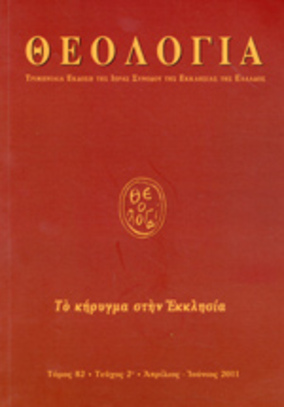Ἡ Χριστιανικὴ «Πόλη τοῦ Κωνσταντίνου» (330) : Ἡ ἑορτὴ τοῦ Μάρτυρα Μωκίου (11/5) καὶ ἡ Μεσοπεντηκοστὴ
Part of : Θεολογία : τριμηνιαία έκδοση της Ιεράς Συνόδου της Εκκλησίας της Ελλάδος ; Vol.85, No.1, 2014, pages 191-234
Issue:
Pages:
191-234
Parallel Title:
THE CHRISTIAN CITY OF CONSTANTINE (330) : THE FEAST OF MARTYR MOKIOS (11/5) AND MESOPENTECOSTE
Author:
Abstract:
A Christian foundation version of Constantinople (roman foundation: consecratio: November 8, 324, during the feast of Mundus Patet; dedicatio: May 11, 330, during the feast of Lemuria) is given by Eusebius of Caesarea, defining its dedication (καθιερουν) to the “God of the Martyrs” (Live of Constantine III.48.1-2 & III.36.1). It was usual for Constantine to replace roman feasts to a christian point of view, as he did in the case of the encainies of Saint Saviour of Lateran, the first cathedral of Rome and the World (8/9 November 318). So, based on a feast of the Deads, perhaps he created an analogous feast of Souls of the Martyrs during the dedication of Constantinople, because of the coincidence of the roman feast of the day (Lemuria, 9, 11, 13 May). Indeed, Constantine honoured particularly the Martyrs, par example in Rome (313) after his victory (Theophanes, ed. Bonn, 20). However, except of the honour of the local martyr Mokios at May 11th, the saint of the foundation of the city, causes interest the existence in the following centuries of the imperial feast of the Mesopentecostè (‘Mediante die Festo’, 25th day of the period from Easter to Pentecost), celebrated again at the church of Saint Mokios at Constantinople. It seems a remnant of the dedication ceremonies of 330. If the performance of the original feast of ‘Mediante die Festo’ (later Mesopentecostè), (when Jesus Christ during the feast of Tabernacles according John 7.1 ff was elevated Himself as Messiah of God) at 330, May 13th (=third day of Lemuria), happened at the 25th year of the Constantine reign, is valid, it would be a simple celebration (Mass on the tomb of a local martyr ?) in the memory of the souls of Martyrs on the occasion of the ordinary fourth post-Easter week ecclesiastical Synaxis. There is only two sources for this hypothetical feast of Martyrs of May 13th (359: Nisibis. 609: Rome, Pantheon, transformed as christian church in the name of Virgin Mary and Martyrs. At that point it could officially (or something else) take place by the Christian community of the city and by the bishops who were always was gathered to the openings of the great imperial churches of the 4th century, the elevation of Constantine as the representative and governor of God on earth. This special point of constantinian ideology happened officially, according to the Tricennial speech of Eusebius, five years later at Jerusalem, during the opening of the church/martyrium of Anastasis (335). Here, according to Egeria (c.385), the Synod of the universal Church celebrated an eighth days feast (13-20 September), in imitation of the feast of Tabernacles. So, the 17th September dedication of the Anastasis Church accordig Chronicon Paschale, was analogous to the Feast of ‘Mediante die Festo’, both being feasts of the Wisdom (Sophia) of God. Either way, Constantine after 313 and during all his great moments, especially at the foundation of Constantinople, he was keenly promoting its dynastic character and praising his family. If something like this disappeared during the next years is because in general was exceeded the ‘personal Christianity’ of Constantine, which was applied with special emphasis at his Mausoleum (337), where he buried in the middle of the Twelve Apostles. Also his program based on the feasts of the roman calendar, giving them a Christian mantle, as in this case of Mundus patet (Rome, Cathedral of Lateran, 8/9 Nov. 318; Constantinople, 8 Nov. 324) and especially the Lemuria, which was replaced to the early celebration of the martyrs of the Pentecost.
Subject:
Subject (LC):




